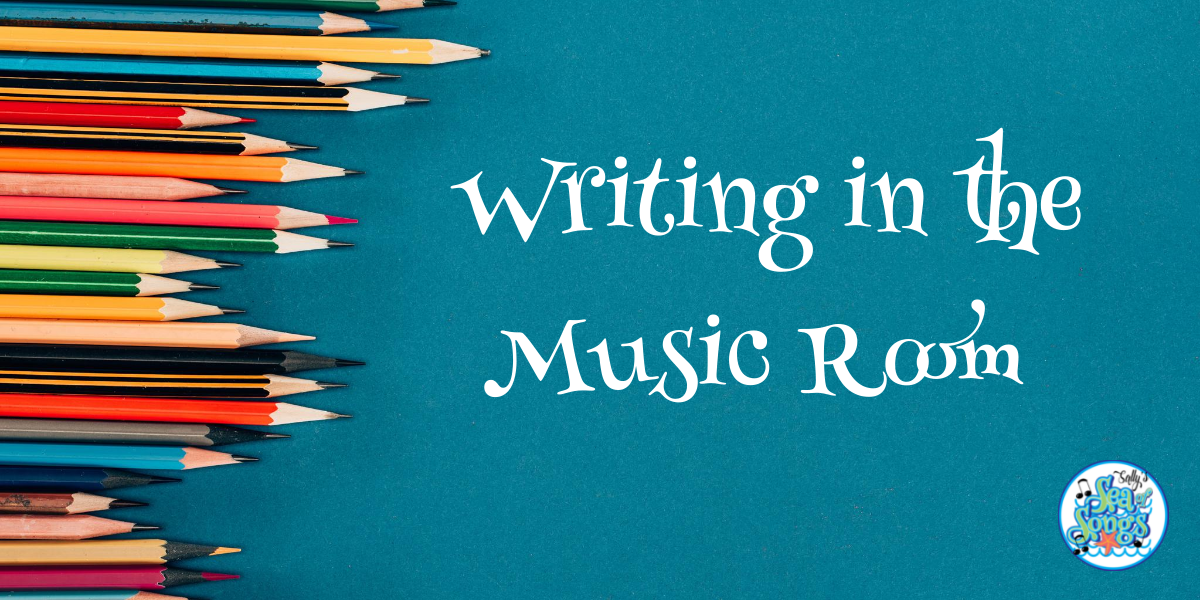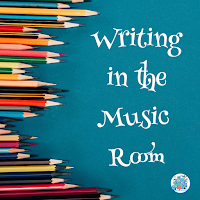The scene: All the teachers are sitting in the same school professional development session where the principal or curriculum coach is describing the new district focus for the year. Writing across the curriculum. All teachers are to include writing in their lessons. Have you been there? I have! How are we music teachers to do this when we only see students for a short time each week? Read on for some easy ways to incorporate writing into your music classes.
Group Collaborative Writing
When I pressed the issue of limited time with administration, I discovered that everybody doesn't always have to write! We could collaborate on our writing as a whole group or in small groups or pairs and it was fine to mix it up. This was freeing! We could work on a description of our music activity or a report on a field trip as a group.
I used this strategy at the beginning, as I was developing procedures for our writing time. These group collaborative writings also served as demonstrations to teach the students how to write on their own. I would be the one to take notes and display them with the projector or with a document camera so the students could add on or edit. I'll share more specific ideas below.
Writing for Different Purposes
In the beginning, I admit that I was envisioning many paragraphs and editing and dictionaries (which I don't have in my class), and whew! That was too much! Then I learned that the English Language Arts standards included writing for different purposes. This could be the answer!
TO INFORM - share facts and other information. - Composers or Music History topics fit in here.
- One quick possibility is to present your lesson, then have each student write one thing they remember on a sticky note. Gather the sticky notes and rearrange them into a paragraph. Students will call out any missing facts to complete your class report!
- For a longer project, allow students to research a composer, genre, or musician and write a report with guidelines that you provide.
TO EXPLAIN - to tell what, how, and why about a topic.
- Explain how to play a recorder, ukulele, or other classroom instruments.
- Explain how to do a folk dance.
- Explain a new music vocabulary term.
- Play a piece of music and let them write instruments, tempo, dynamics they hear, identify (or guess) the genre, give a possible use for the music. Many music educators call this SQUILT - Super Quiet Un-Interrupted Listening Time.
TO NARRATE - to tell a story.
- The story can be made up or truthful. The story can be long or short.
- Write a simple story to cover the beginning, middle, and end. For younger students, this story could consist of 3 sentences! For older students, the story could be 3 paragraphs and include more details.
- Add instruments or songs to the story to create a mini-performance.
TO PERSUADE - state an opinion or goal and support it with reasons and supporting details in order to convince the reader to agree, take action, or both.
- Write school newsletter announcements for upcoming programs.
- Persuade classmates to join the choir or other performing groups.
- Persuade others to listen to a new genre of music.
ENTERTAIN - to engage the reader using techniques such as humor, adventure, or suspense.
- Play music and have students write or draw what they picture. Create a great story to go along with the music!
- Give students an opportunity to present their drawings or writing and explain them to the class.
- As an extension, write a brief explanation of the picture. This would make a great bulletin board display.
EXPRESS - to share thoughts or feelings.
- Write about their feelings when they were performing on stage.
- How does this music make you feel? Why? Use music vocabulary to support your ideas.
- Writing poetry that could be set to music is a great option.
- As a preliminary step to poetry writing, give students a word and ask the class to write as many rhyming words as they can think of.
EVALUATE - describe the positive and negative aspects and present evidence for support.
- Book, music, or concert reviews fit this category.
- Evaluating music and music performances is a part of state and national music standards.
- Begin with short reviews of video performances. Include music vocabulary and evidence from the video to support the evaluation.
- Reflect on school concerts. My students always love to see themselves in a video! Check out how I use this type of writing following every concert here.
Helpful Resources
Writing prompt templates help me organize my plans for writing in the music room, especially last year when we were switching between virtual and in-person classes. The
writing prompt templates are just the size to write a question or prompt to guide student writing.
For a quick write, consider using sticky notes, whiteboards, sentence strips, or exit tickets. These blank
exit tickets are great for short questions or statements about what students learned in class.
For longer projects, journals or special writing paper are more appropriate. Those special writing papers really make a nice bulletin board showing off student work!
Nutcracker Notetaking includes a graphic organizer which I use as a space for students to take notes while we are reading the story of the ballet. Then, the completed organizer serves as the pre-writing for a report on our field trip to the ballet.
Another example of a special writing paper comes in this
Pirate Writing Paper set. This was perfect for my first graders to use following a trip to see the musical,
How I Became a Pirate.
Free Writing Prompt List
Looking for more ways to integrate writing into your music classroom? Grab my free list of 25+ writing prompts designed just for music teachers!
- Fill out the form at the bottom of this page.
- Check your inbox to receive the password to the Members Area of this blog.
- Come back here and click on the Members link at the top of the page to find the Free Resource Library.
Let’s make writing in music class fun and meaningful!
Just Do It!
I am a firm believer in arts integration. While it is really awesome when I can help classroom teachers authentically integrate music into their lessons, I also need to be willing to integrate other areas of the curriculum into my classes.
It takes the creativity of an arts educator to extract principles from those one-size-fits-all professional development sessions and integrate them into our classes. You are that creative music teacher! You can do this! Our students are better served when they can make connections across the curriculum.
As I said at the beginning, everyone doesn't have to write every time. Every writing activity doesn't have to end up on a bulletin board, although writing does make for a great display. Some of the above examples are very quick and easy. Others may take the entire class period or more. The key is to just do it as a natural part of your music lesson.
How do you incorporate writing into your music lessons? Let me know in the comments!
References
https://www.sadlier.com/school/ela-blog/teaching-students-the-many-purposes-of-writing
https://literacyideas.com/authors-purpose/
https://forms.hmhco.com/assets/pdf/journeys/Journeys_CC_Writing_Handbook_Gr6.pdf


























.png)


